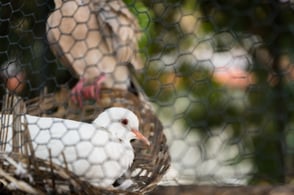Sculptures Made with Chicken Wire?
There are many different uses for chicken wire. It is much more versatile than you might expect. Here, a unique practice is crafting the hexagonal netting into sculptured works of art. Ivan Lovatt, a sculptor from Australia, has created a stunning collection of artwork. Using galvanized chicken wire, he has made representations of both people and wildlife. A bust of John Lennon? Bring it on. This type of chicken wire is moldable with a neutral yet characteristic sheen. The small, light gauge mesh allows him to bend, fold, crease, and cut the mesh into its final shape. The result is an amazingly life-like rendition. Take a look at this video and see what you think:
A Wide Variety of Applications
The most common specifications of chicken wire available are made using 20 gauge wire woven into 1" or 2" hexagonal mesh. Other types available are ½" x 22 gauge, 1" x 18 gauge, and 1½ x 17 gauge.
Finishes available are: galvanized before weave (GBW), galvanized after weave (GAW), PVC vinyl coated (VC), and stainless steel. Not all specifications are available in all finishes.
This fencing material is ideal for use around the home, farm, and in industrial applications - any place where a lighter weight mesh can be used. Here are some conventional uses:
- deer fence
- craft projects
- stucco netting
- window guards
- game bird flight pens
- garden perimeter fence
- tree and shrub protection
- holding
insulation in place - exclusion barriers for birds
- chicken runs and poultry houses
- trellis for climbing plants & flowers
- backing mesh for post and rail fence
- framework for sculpture and float decorations
Yep, not just for chickens!
How many different ways can you think of using chicken wire? Have you tried using it that way?
![]()

P.S. See the finished bust of John Lennon here.















